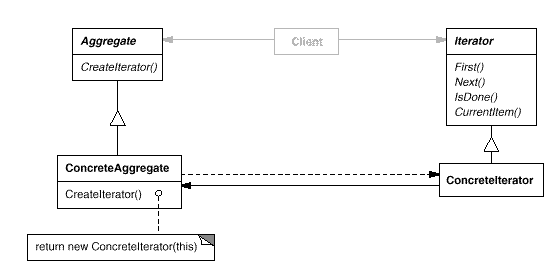- Aka: Cursor
- Intent: Provide a way to access the elements of an aggregate object sequentially without exposing its underlying representation.
Structure §

Image from: Gamma, Helm, Johnson, and Vissides
Applicability §
- There is a need to access an aggregate object’s contents without exposing its internal representation.
- Support multiple traversals of aggregate objects.
- Provide a uniform interface for traversing different aggregate structures
Consequences §
- It supports variations in the traversal of an aggregate.
- Iterators simplify the aggregate interface.
- More than one traversal can be pending on an aggregate
Implementation §
Iteration Controllers §
- External iterators – client controls the iterator. More flexible
- Internal iterator – the iterator controls the iteration. Easier to use.
Traversal Algorithm §
- The aggregate defines the traversal algorithm and a client invokes the next operation to change the state of the iterator
- The iterator is responsible for traversal. This is not viable if private variables need to be accessed
Robustness §
- If the list is modified while it is traversed, at the cost of memory, copy the aggregate and traverse the copy.
- Use robust iterators to ensure insertions and removals won’t interfere with traversal. One solution: register the iterator with the aggregate, on modification, the aggregate adjusts the iterator’s state or it maintains information internally.
- Make additional iterator operations according to use.
- Iterators may have privileged access. Make iterators friends of the aggregate if possible, and include protected operations for subclassing.
- Use an external iterator
- If the composite has an interface for traversal, then keeping track of the current node in the composite is better.
- Use Null Iterators to handle boundary conditions on empty objects by ensuring it is always done.
